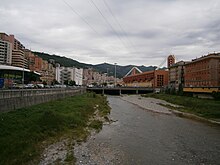Bisagno
| Bisagno | ||
|
The Bisagno at the height of the Genoese district of Marassi |
||
| Data | ||
| location | Liguria , Italy | |
| River system | Bisagno | |
| River basin district | Appennino Settentrionale | |
| source | Passo della Scoffèra , Ligurian Apennines | |
| Source height | 850 m slm | |
| muzzle |
Ligurian Sea Coordinates: 44 ° 23 ′ 42 " N , 8 ° 56 ′ 34" E 44 ° 23 ′ 42 " N , 8 ° 56 ′ 34" E
|
|
| length | 30 km | |
| Big cities | Genoa | |
| Communities | Bargagli and Davagna | |
The Bisagno is a torrent river in the northern Italian region of Liguria . Together with the Polcevera , it is one of the main rivers of the port city of Genoa . In the valley of the same name, there are 12 districts of Genoa as well as the communities of Bargagli and Davagna . The tributaries include the Lentro and Canate torrents, as well as the smaller rivers Rio Geirato, Rio Molassana and Rio Fereggiano. In the urban area of Genoa, the river has been heavily built over with parking lots, roads and leisure facilities for reasons of space. B. at the football stadium . From the Genova Brignole train station , the Bisagno was completely built over with a road. The river flows into the Gulf of Genoa under the exhibition center at Piazzale John Fitzgerald Kennedy .
history

The length of the Bisagno is about 30 kilometers. In pre-Roman antiquity , the river bed was about four times wider and deeper than it is today. About five kilometers from the coast, the inland settlement Σταλία (Stalia, today Staglieno ) developed on the banks of the Bisagno with its own port. Genoa would later develop from it.
As a torrent river, the Bisagno is often dried up in summer and winter. In the seasons with more rainfall, however, there are always high water levels and occasional floods such as on October 7, 1970 and November 4, 2011. During the last flood in 2011, the Bisagno entered the zone between Piazzale Adriatico at around 12:40 and the Borgo Incrociati overflowed and flooded large parts of Genoa city center and the Brignole train station . However, the greatest damage and six fatalities were caused by the Rio Fereggiano .
Flora and fauna
The banks of the river are densely overgrown with thorn bushes, shrubs and trees typical of the Mediterranean maquis . In addition, pheasants , gray herons , various types of gulls , ravens and crows , as well as mallards and other duck birds have found a habitat in this relatively isolated area .
Web links
- La Vita nel Bisagno (Italian)
- November 2002 flood data (Italian)
